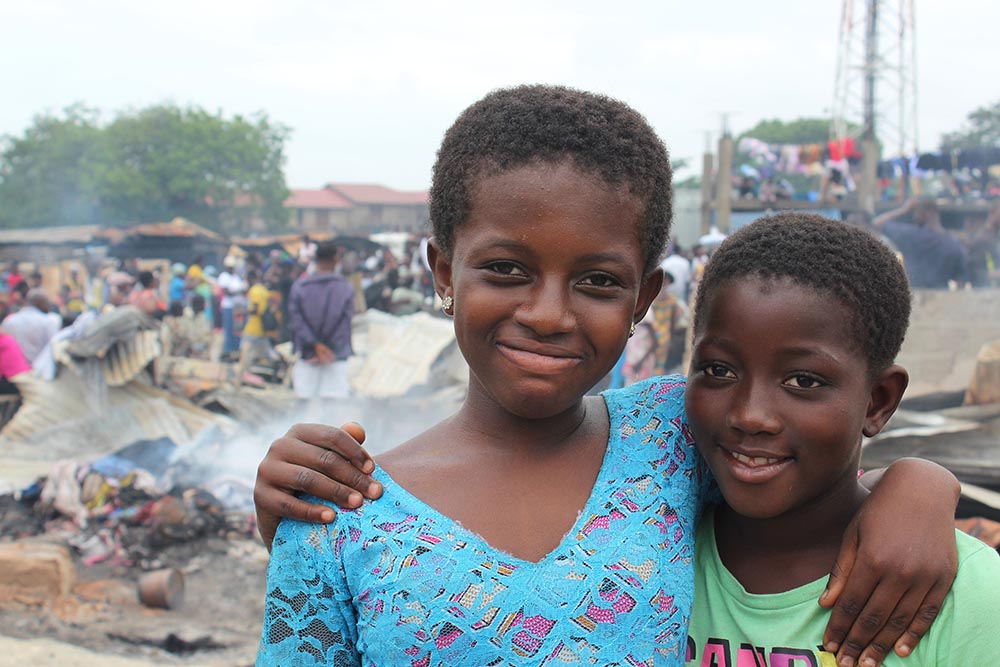I didn’t bring my camera along very often during the first two weeks of my internship. There were a couple of reasons for this. Firstly, I consider myself to be more inclined as a writer or an audio person than a photographer, which is why I requested to be placed at a radio station for my internship in the first place. Secondly, my relatively small stature tends to make my already big “obruni” backpack look even more enticingly enormous, so I figure the fewer bulky, pricey goodies I lug around in it, the better.
However, last Tuesday night, I decided on a whim to pack my camera up with my other work stuff. I figured I would at least take some good pictures of my coworkers and the office place for a future blog post. And take pictures for a future blog post I did indeed.
The next morning I was sitting in the greenroom, semi-napping in between sifting through batches of messages sent into Citi FM’s “Breakfast Show” (which goes on air at 6:20 AM every week day) when my producer asked if I wanted to go out on an assignment that day.
Obviously, the answer was yes. I had only been on a couple assignments so far and they were mostly shadow experiences, but this time I could actually take pictures and contribute something to the final story. So as soon as the show was over at 10 AM, I skipped upstairs to the newsroom to meet up with the coworker I’d be going on assignment with.
The coworker I was assigned to, Kojo, called me over to him in the newsroom. He told me we were leaving in a few minutes to visit a slum neighborhood called Abuja that had been burned to the ground the night before.
I was surprised. I had seen a short story with updates about the fire the night before but it never occurred to me while packing up my camera that I’d actually be going out to take pictures of it the next day.
When we got to the scene, I realized that I had no idea what to do. I also realized that sandals were the incorrect shoe choice for that day. As we began pushing in towards the center of the mess of burned structures, steaming piles of rubble, and displaced residents of the area, Kojo told me that I could take pictures of anything I wanted. I raised my camera to my eye and started taking pictures of the ground.
Kojo must have noticed my fascination with random piles of charred schoolwork and cookware because he started telling me to take pictures of the crowds of people milling around trying to locate what few remaining belongings they had, and of the gutted wood and cement structures that had once been these people’s homes. At some point he even lifted me up onto one of the burned structures so I could get a better overall shot of the scene. Soon, I found I entered a state that I had heard a few of my classmates describe after visiting a couple of hospitals for some work we’re doing with an NGO in the area: robo-journalist.
Within the half hour we were there, I took almost a hundred photos. The only one I was not permitted to take was of a young woman Kojo interviewed whose sister had supposedly lost her baby during the fire. I say supposedly because there was no way to confirm that this woman was in any way related to the single person who had perished because of the fire (a baby boy), and also because we had been repeatedly told by people that we could only interview them if we gave them money. We did buy the young woman and her friend water sachets for their trouble.
When you’re looking through a camera lens, it’s easy to forget about where you are and to separate yourself from the people you’re capturing forever with just a click of a button. That’s definitely where I was for most of my time visiting the scene of the Abuja slum fire. But towards the end of it, I was pulled out for just a second.
While Kojo was talking to some men about the events of the fire, I noticed two little girls trailing behind me who smiled and waved when I looked back at them. I saw them eyeing my camera and so I asked if they wanted me to take a picture of them. I don’t know if they understood me or not, but they posed confidently for the camera, their arms around one another. Superimposed on a backdrop of smoldering ash and rubble, the girls smiled when I raised my camera to my eye – as if it didn’t even matter that their homes and belongings had been lost forever less than 24 hours before.
I did not submit this photo to be used in the story that was published on the Citi FM website (which is linked below), but it’s the photo I remember the most when I think about that day. It will probably be one of the moments that I will remember the most from this experience as a whole, because it helped to remind me that the most important part of the story isn’t always seen through the lens of a camera alone.
Check out the story on the Citi FM website here.





